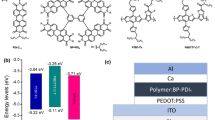Abstract
Core substituted perylene diimides (PDIs) are promising candidates as non-fullerene acceptor materials for organic solar cells. The functionalization of PDIs in the bay positions using chemical groups with different electron donating abilities and with steric hindrance is a versatile tool to modify both the optoelectronic properties and the morphology in the solid state. Herein we present two new PDI based molecules having bulky aromatic substituents linked into the bay positions: PDI-SF with spirobifluorene group and PDI-BSF with bithienyl-spirobifluorene moieties. The high steric hindrance of spirobifluorene reduce the tendency to form aggregates that has been identified as a limiting factor for the photovoltaic performances in PDI based solar cells.
The PDI molecules were tested as electron acceptors in bulk heterojunction solar cells with P3HT as electron donor. Power conversion efficiencies (PCE) of 1.58% and 1.18% were obtained for PDI-SF and PDI-BSF devices.
Similar content being viewed by others
References
Y. J. He, Y. F. Li, Phys. Chem. Chem. Phys. 13, 1970 (2011).
T. D. Nielsen, C. Cruickshank, S. Foged, J. Thorsen, F. C. Krebs, Sol. Energy Mater. Sol. Cells 94, 1553 (2010).
Z. B. Henson, K. Müllen, G. C. Bazan, Nature Chem. 4, 699 (2012).
F. Wurtner, Chem. Comm. 14, 1564 (2004).
E. Kozma, M. Catellani, Dyes and Pigments 98, 160 (2013).
A. Mishra, P. Bäuerle, Angew. Chem. Int. Ed. 51, 2020 (2012).
J. L. Segura, H. Herrera, P. Bäuerle, J. Mater. Chem., 22, 8717 (2012).
E. Kozma, D. Kotowski, S. Luzzati, M. Catellani, F. Bertini, A. Famulari {etet al.}, RSC Adv. 3, 9185 (2013).
E. Kozma, D. Kotowski, M. Catellani, S. Luzzati, M. Cavazzini, A. Bossi, S. Orlandi, F. Bertini, Mater. Chem. Phys., submitted (2015)
D. Mori, H. Benten, I. Okada, H. Ohkita, S. Ito, Adv. En. Mater. 4, 1301006 (2014).
R. Steyrleuthner, S. Bange, D. Neher, J. Appl. Phys. 105, 064509 (2009).
G. Li, V. Shrotriya, J. Huong, Y. Yao, T. Moriarty, K. Emery, Y. Yang, Nat. Mat. 4, 864 (2005).
acknowledgments
This work has been supported by Regione Lombardia and CNR (Cluster Project ‘Energy’ n° 17348), by Fondazione Cariplo (project “PLENOS”, Ref 2011-0349) and the E.U. Marie Curie RG project “DAMASCO” FP7-PEOPLE-2010-RG-268229.
Author information
Authors and Affiliations
Rights and permissions
About this article
Cite this article
Kotowski, D., Luzzati, S., Kozma, E. et al. N-type semiconducting perylene diimide based molecules for organic solar cells. MRS Online Proceedings Library 1733, 27–32 (2014). https://doi.org/10.1557/opl.2015.16
Published:
Issue Date:
DOI: https://doi.org/10.1557/opl.2015.16




